2005 Hyundai H-1 (Grand Starex) tow
[x] Cancel search: towPage 98 of 205
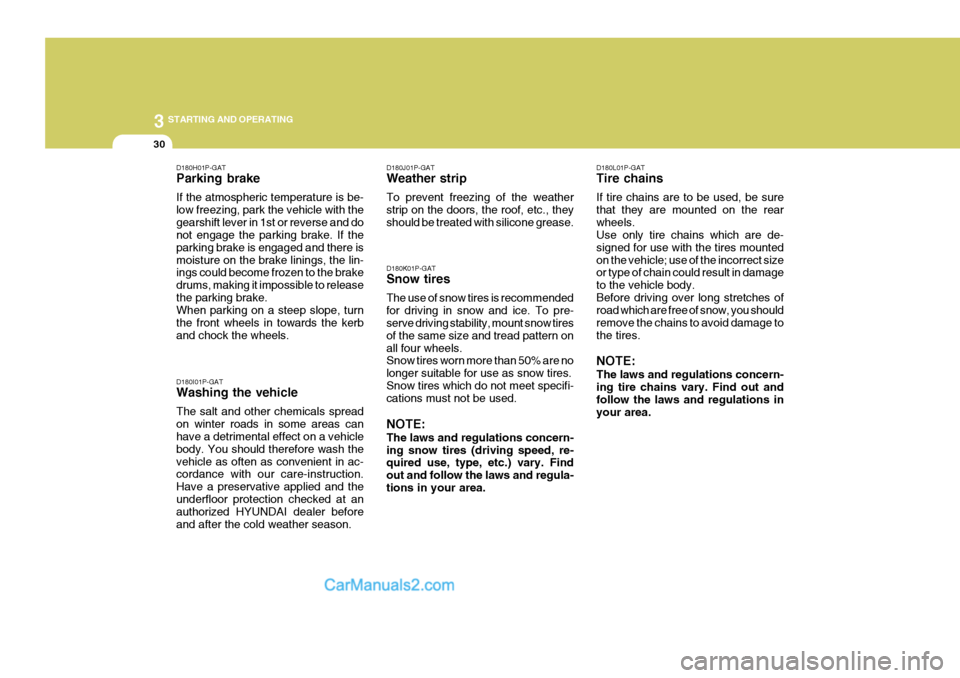
3 STARTING AND OPERATING
30
D180J01P-GAT Weather strip To prevent freezing of the weather strip on the doors, the roof, etc., theyshould be treated with silicone grease. D180K01P-GAT Snow tires The use of snow tires is recommended for driving in snow and ice. To pre- serve driving stability, mount snow tires of the same size and tread pattern onall four wheels. Snow tires worn more than 50% are no longer suitable for use as snow tires.Snow tires which do not meet specifi- cations must not be used. NOTE: The laws and regulations concern- ing snow tires (driving speed, re- quired use, type, etc.) vary. Find out and follow the laws and regula-tions in your area.D180L01P-GAT Tire chains If tire chains are to be used, be sure that they are mounted on the rearwheels. Use only tire chains which are de- signed for use with the tires mountedon the vehicle; use of the incorrect size or type of chain could result in damage to the vehicle body.Before driving over long stretches of road which are free of snow, you should remove the chains to avoid damage tothe tires. NOTE: The laws and regulations concern- ing tire chains vary. Find out and follow the laws and regulations in your area.
D180H01P-GAT Parking brake If the atmospheric temperature is be- low freezing, park the vehicle with thegearshift lever in 1st or reverse and do not engage the parking brake. If the parking brake is engaged and there ismoisture on the brake linings, the lin- ings could become frozen to the brake drums, making it impossible to releasethe parking brake. When parking on a steep slope, turn the front wheels in towards the kerband chock the wheels. D180I01P-GAT Washing the vehicle The salt and other chemicals spread on winter roads in some areas can have a detrimental effect on a vehicle body. You should therefore wash thevehicle as often as convenient in ac- cordance with our care-instruction. Have a preservative applied and theunderfloor protection checked at an authorized HYUNDAI dealer before and after the cold weather season.
Page 102 of 205

4
Tools and Jack ............................................................. 4-2
Spare Tire ..................................................................... 4-3
If You Have a Flat Tire ................................................. 4-6
Changing a Flat Tire ..................................................... 4-7Towing........................................................................ 4-13
Bleeding the Fuel System .......................................... 4-18
Removal of Water from the Fuel Filter ....................... 4-19
If the Engine Will Not Start ......................................... 4-20
Jump Starting ............................................................. 4-21
If the Engine Overheats ............................................. 4-22
Checking and Replacing Fuses ................................. 4-24
Headlight Aiming Adjustment ..................................... 4-26
Replacement of Light Bulbs ....................................... 4-27
Bulb Wattage .............................................................. 4-35
Fuse Panel Description .............................................. 4-37
IN CASE OF EMERGENCY
4
Page 103 of 205

44IN CASE OF EMERGENCY
2
Release valve
TOOLS AND JACK
E010A01P-GAT To provide for cases of emergency, always remember where the tools and jack are stowed and how the jack is removed for use.
E010B03P-GAT Storage places E010C03P-GAT TOOLS
E020A01P-GATJACK To use the jack
The tool box is at the right rear corner of the luggage compartment (minibus/ van) or on the floor behind the seat(truck). Minibus/Van Truck
1. Tool case
2. Wheel nut wrench
3. Screwdriver
4. Spare wheel carrier wrench(Truck only) 4
Turn the knob clockwise, and then remove the lid. Remove the securing nut, and then take out the jack.
E010B01P-2 E010C03P
E020A01P
Minibus/Van Truck
Securing nut
Ram 1
2 3
Page 114 of 205
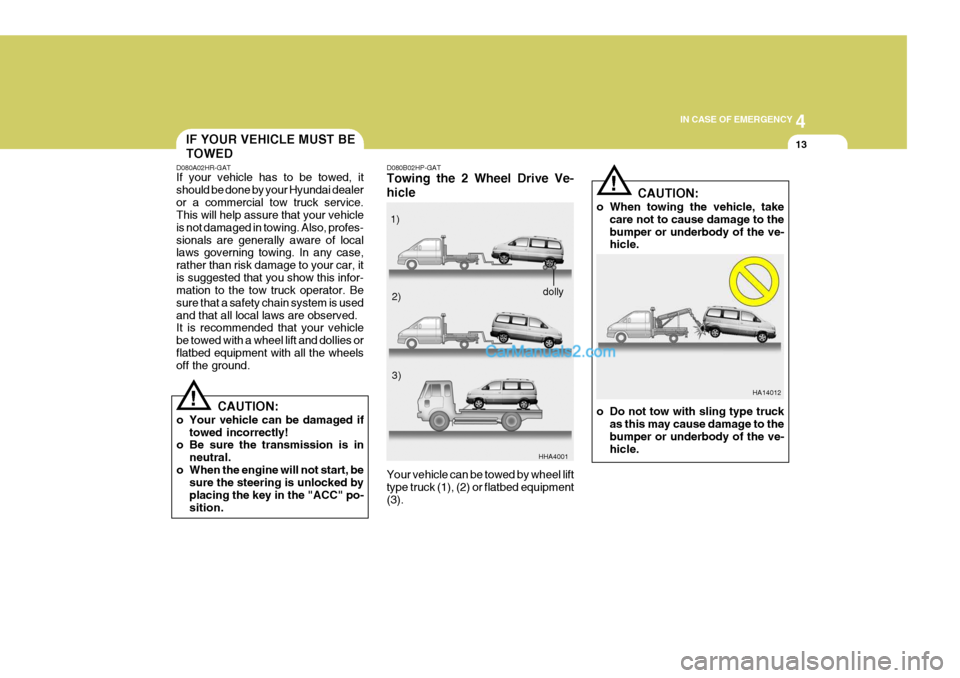
4
CORROSION PREVENTION AND APPEARANCE CARE
13
4
IN CASE OF EMERGENCY
13IF YOUR VEHICLE MUST BE TOWED
D080A02HR-GAT If your vehicle has to be towed, it should be done by your Hyundai dealeror a commercial tow truck service. This will help assure that your vehicle is not damaged in towing. Also, profes-sionals are generally aware of local laws governing towing. In any case, rather than risk damage to your car, itis suggested that you show this infor- mation to the tow truck operator. Be sure that a safety chain system is usedand that all local laws are observed. It is recommended that your vehicle be towed with a wheel lift and dollies orflatbed equipment with all the wheels off the ground.
! D080B02HP-GAT Towing the 2 Wheel Drive Ve- hicle
HHA4001
Your vehicle can be towed by wheel lift type truck (1), (2) or flatbed equipment (3).
CAUTION:
o Your vehicle can be damaged if towed incorrectly!
o Be sure the transmission is in
neutral.
o When the engine will not start, be sure the steering is unlocked by placing the key in the "ACC" po-sition. 1)
2)
3)
dolly
HA14012
CAUTION:
o When towing the vehicle, take care not to cause damage to the bumper or underbody of the ve- hicle.
o Do not tow with sling type truck as this may cause damage to the bumper or underbody of the ve-hicle.
!
Page 115 of 205
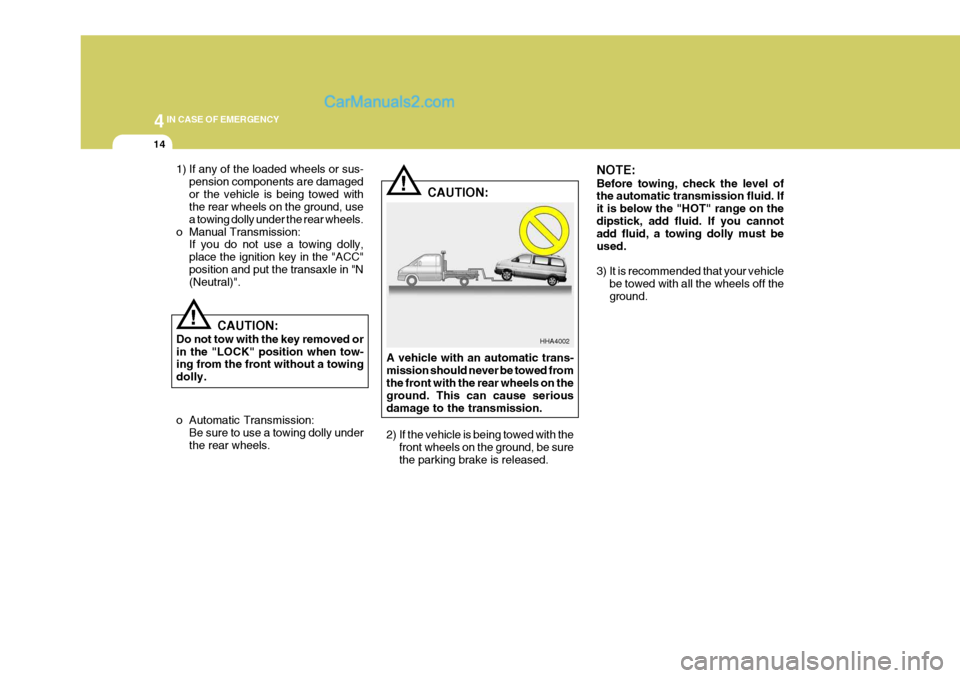
44IN CASE OF EMERGENCY
14
!
!
1) If any of the loaded wheels or sus-
pension components are damaged or the vehicle is being towed with the rear wheels on the ground, use a towing dolly under the rear wheels.
o Manual Transmission: If you do not use a towing dolly,place the ignition key in the "ACC"position and put the transaxle in "N (Neutral)".
HHA4002
CAUTION:
Do not tow with the key removed or in the "LOCK" position when tow- ing from the front without a towing dolly. A vehicle with an automatic trans-mission should never be towed from the front with the rear wheels on the ground. This can cause seriousdamage to the transmission.
2) If the vehicle is being towed with the
front wheels on the ground, be sure the parking brake is released.
o Automatic Transmission:
Be sure to use a towing dolly under the rear wheels. CAUTION:
NOTE: Before towing, check the level of the automatic transmission fluid. If it is below the "HOT" range on thedipstick, add fluid. If you cannot add fluid, a towing dolly must be used.
3) It is recommended that your vehicle
be towed with all the wheels off the ground.
Page 116 of 205
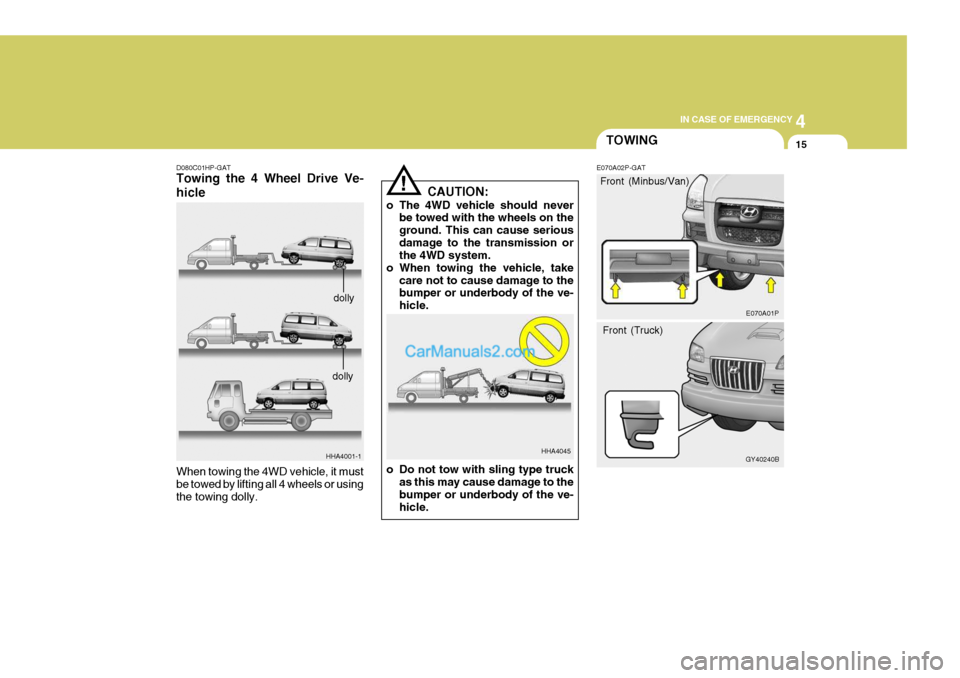
4
CORROSION PREVENTION AND APPEARANCE CARE
15
4
IN CASE OF EMERGENCY
15
CAUTION:
o The 4WD vehicle should never be towed with the wheels on the ground. This can cause seriousdamage to the transmission or the 4WD system.
o When towing the vehicle, take
care not to cause damage to thebumper or underbody of the ve- hicle.!
HHA4045
o Do not tow with sling type truck as this may cause damage to the bumper or underbody of the ve- hicle.
D080C01HP-GAT Towing the 4 Wheel Drive Ve- hicle
HHA4001-1
When towing the 4WD vehicle, it must be towed by lifting all 4 wheels or usingthe towing dolly.
dolly
dolly
TOWING
E070A02P-GAT Front (Minbus/Van)
Front (Truck) E070A01P
GY40240B
Page 117 of 205
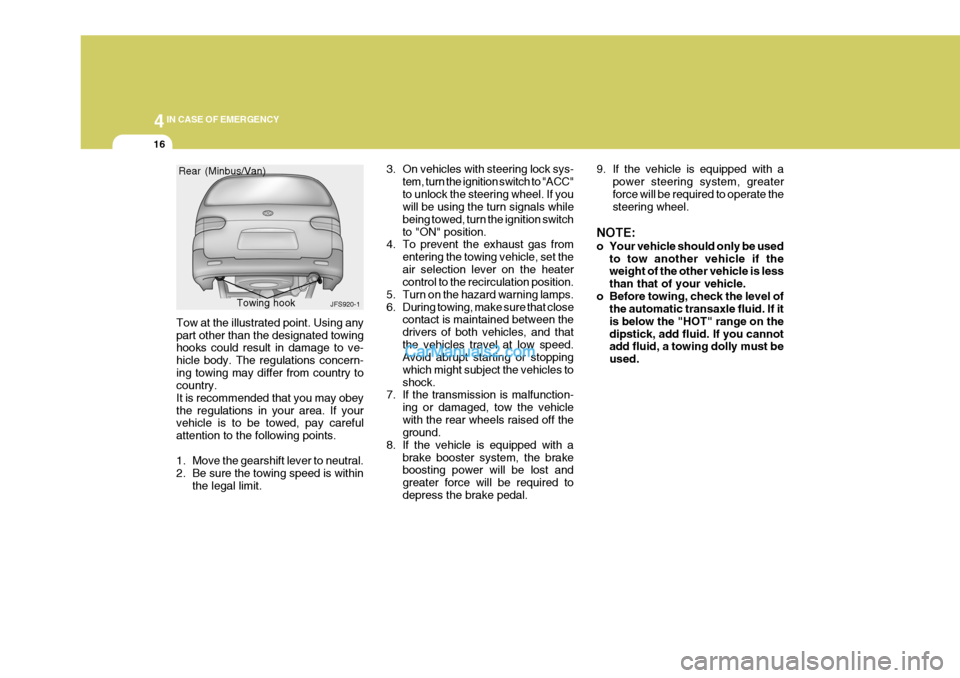
44IN CASE OF EMERGENCY
16
Tow at the illustrated point. Using any part other than the designated towing hooks could result in damage to ve- hicle body. The regulations concern-ing towing may differ from country to country. It is recommended that you may obeythe regulations in your area. If your vehicle is to be towed, pay careful attention to the following points.
1. Move the gearshift lever to neutral.
2. Be sure the towing speed is within
the legal limit. 3. On vehicles with steering lock sys-
tem, turn the ignition switch to "ACC"to unlock the steering wheel. If you will be using the turn signals while being towed, turn the ignition switchto "ON" position.
4. To prevent the exhaust gas from
entering the towing vehicle, set theair selection lever on the heater control to the recirculation position.
5. Turn on the hazard warning lamps.
6. During towing, make sure that close contact is maintained between thedrivers of both vehicles, and thatthe vehicles travel at low speed. Avoid abrupt starting or stopping which might subject the vehicles toshock.
7. If the transmission is malfunction-
ing or damaged, tow the vehiclewith the rear wheels raised off the ground.
8. If the vehicle is equipped with a brake booster system, the brakeboosting power will be lost and greater force will be required todepress the brake pedal.
JFS920-1
Rear (Minbus/Van)
Towing hook
9. If the vehicle is equipped with apower steering system, greater force will be required to operate the steering wheel.
NOTE:
o Your vehicle should only be used to tow another vehicle if the weight of the other vehicle is less than that of your vehicle.
o Before towing, check the level of the automatic transaxle fluid. If itis below the "HOT" range on thedipstick, add fluid. If you cannot add fluid, a towing dolly must be used.
Page 118 of 205
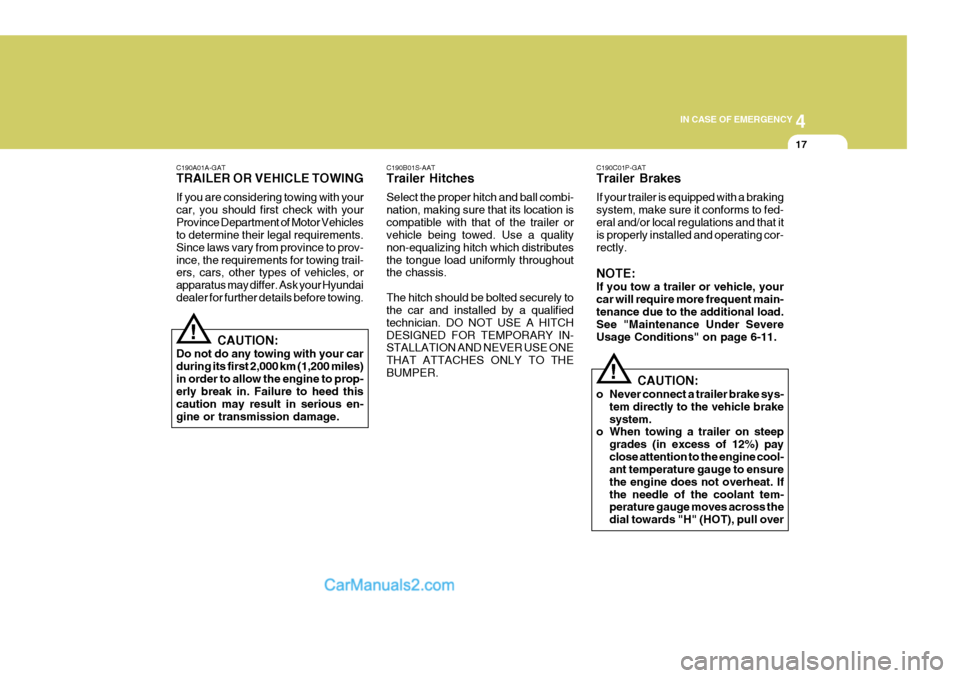
4
CORROSION PREVENTION AND APPEARANCE CARE
17
4
IN CASE OF EMERGENCY
17
C190B01S-AAT Trailer Hitches Select the proper hitch and ball combi- nation, making sure that its location iscompatible with that of the trailer or vehicle being towed. Use a quality non-equalizing hitch which distributesthe tongue load uniformly throughout the chassis. The hitch should be bolted securely to the car and installed by a qualified technician. DO NOT USE A HITCHDESIGNED FOR TEMPORARY IN- STALLATION AND NEVER USE ONE THAT ATTACHES ONLY TO THEBUMPER. C190C01P-GAT Trailer Brakes If your trailer is equipped with a braking system, make sure it conforms to fed-eral and/or local regulations and that it is properly installed and operating cor- rectly. NOTE: If you tow a trailer or vehicle, your car will require more frequent main-tenance due to the additional load. See "Maintenance Under Severe Usage Conditions" on page 6-11.
CAUTION:
o Never connect a trailer brake sys- tem directly to the vehicle brakesystem.
o When towing a trailer on steep
grades (in excess of 12%) payclose attention to the engine cool- ant temperature gauge to ensure the engine does not overheat. Ifthe needle of the coolant tem- perature gauge moves across the dial towards "H" (HOT), pull over
!
C190A01A-GAT TRAILER OR VEHICLE TOWING If you are considering towing with your car, you should first check with yourProvince Department of Motor Vehicles to determine their legal requirements. Since laws vary from province to prov-ince, the requirements for towing trail- ers, cars, other types of vehicles, or apparatus may differ. Ask your Hyundaidealer for further details before towing.
CAUTION:
Do not do any towing with your carduring its first 2,000 km (1,200 miles)in order to allow the engine to prop- erly break in. Failure to heed this caution may result in serious en-gine or transmission damage.
!